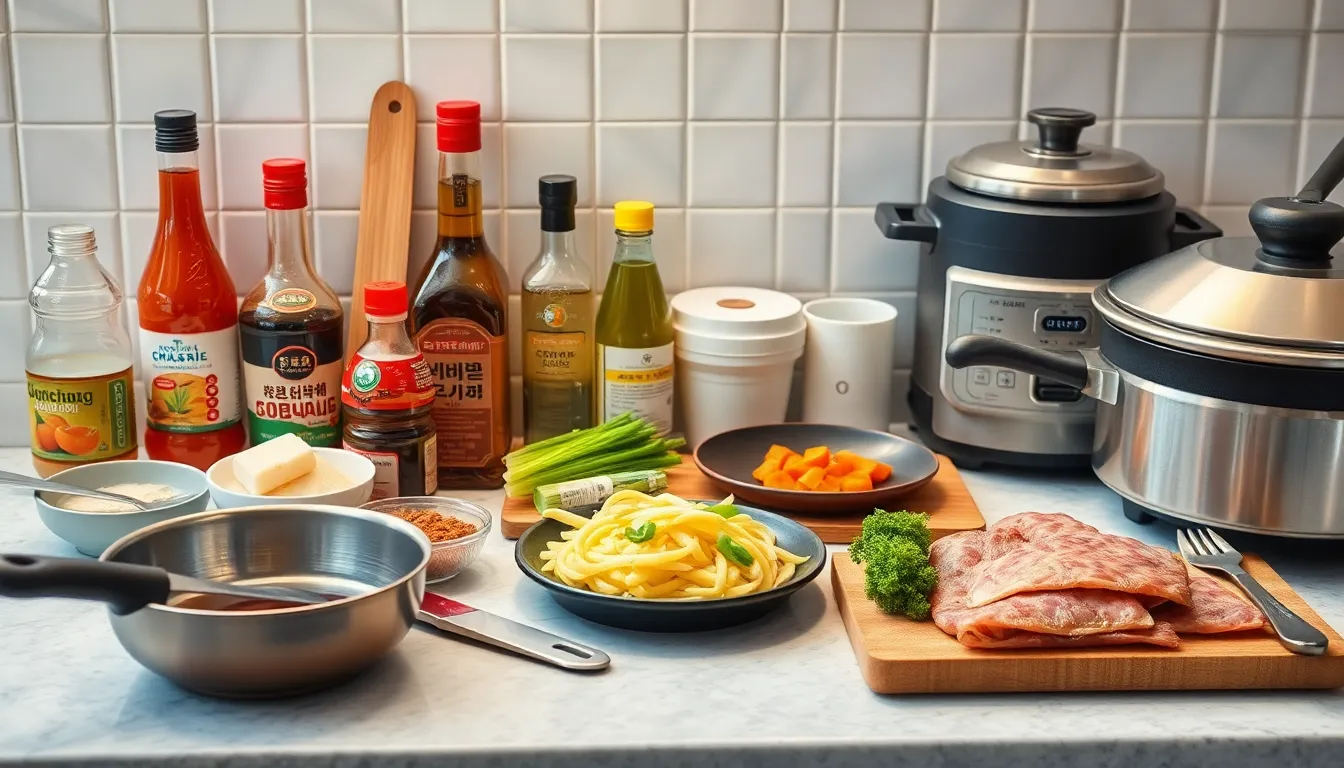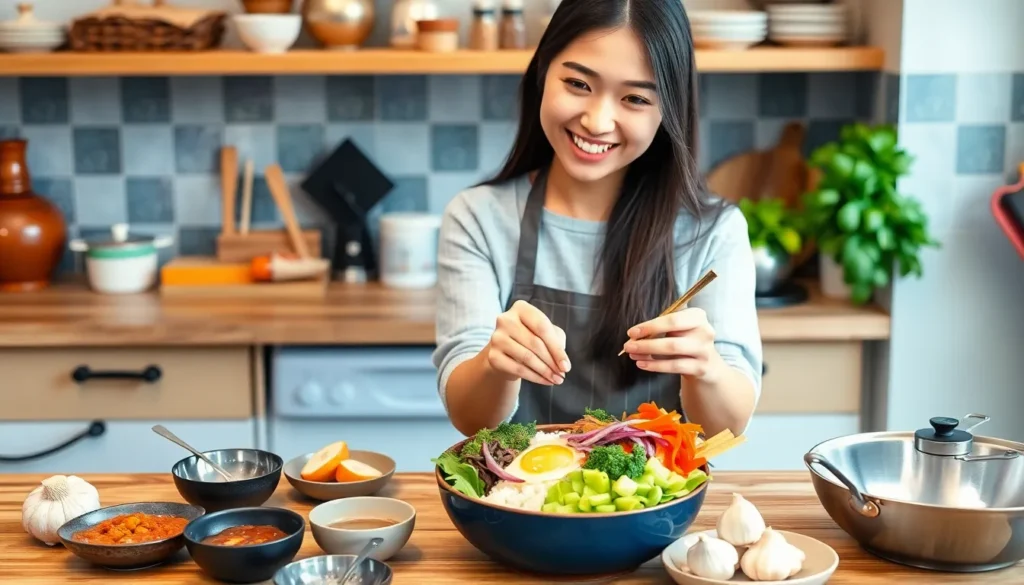Table of Contents
ToggleKorean cuisine is a flavor explosion that’s taken the culinary world by storm. From the spicy kick of kimchi to the savory goodness of bulgogi, it’s hard not to fall in love with these mouthwatering dishes. But why settle for takeout when you can whip up your own Korean feast right in your kitchen?
Popular Korean Dishes to Try at Home
Exploring popular Korean dishes at home offers a delightful culinary adventure. Two of the most famous options are bibimbap and kimchi.
Bibimbap: A Colorful Rice Bowl
Bibimbap features a colorful assortment of fresh vegetables and protein served over rice. Ingredients typically include spinach, carrots, zucchini, mushrooms, and sliced beef or tofu. Each component adds unique flavors and textures, creating a harmonious dish. A fried egg with a runny yolk often crowns the bowl, enhancing its richness. Gochujang, a spicy red pepper paste, provides additional depth and spice. Preparing bibimbap is simple, making it an ideal choice for both novice and experienced cooks.
Kimchi: The Fermented Delight
Kimchi stands out as a staple in Korean cuisine, known for its bold flavors and health benefits. Napa cabbage and radishes commonly form the base of this iconic dish. Fermentation brings out vibrant, tangy tastes, which pair beautifully with many meals. Spices like garlic, ginger, and red pepper flakes create a fiery kick. Making kimchi at home allows customization according to personal tastes and ingredient availability. It’s an essential side dish, served with nearly every Korean meal, and offers probiotic benefits for digestive health.
Essential Ingredients for Korean Cooking

Korean cooking relies on specific ingredients that enhance its distinct flavors. Familiarity with these essentials leads to more successful preparations at home.
Common Spices and Sauces
Gochujang serves as a cornerstone of Korean cuisine. This red chili paste provides a rich, spicy kick and is essential for dishes like bibimbap. Soy sauce adds depth to many meals, offering a savory umami flavor. Sesame oil lends a nutty aroma and is frequently drizzled over finished dishes. Doenjang, a fermented soybean paste, brings a robust taste to stews and soups. Lastly, garlic and ginger are fundamental aromatics that elevate the overall flavor profile of many recipes.
Must-Have Kitchen Tools
A few key kitchen tools simplify the process of Korean cooking. A heavy-duty pan or skillet ensures even cooking for stir-fries and sizzling dishes. A rice cooker streamlines the preparation of fluffy, perfectly cooked rice. Sharp knives assist in chopping vegetables and proteins with precision. Mandoline slicers facilitate uniform slicing of ingredients, enhancing presentation. Lastly, traditional Korean cookware, such as a stone pot (dolsot), enhances the experience by creating crispy rice layers at the bottom of dishes.
Step-by-Step Recipes for Beginners
Korean cuisine offers delicious options that anyone can prepare at home. Below are two easy recipes perfect for beginners.
Simple Korean Stews
Kimchi jjigae, or kimchi stew, stands out as a staple dish. It requires ingredients like ripe kimchi, tofu, pork, and green onions. Start by sautéing pork until it’s cooked through, then add kimchi and stir-fry for a few minutes to enhance the flavor. Next, add water or broth, and bring it to a simmer. Tofu can be added, then let it cook for 10-15 minutes. Serve hot with rice for a comforting meal.
Doenjang jjigae, or soybean paste stew, takes minimal time to prepare. Combine water, diced potatoes, zucchini, and mushrooms in a pot. Once the vegetables soften, mix in doenjang for flavor. Add green onions and let it simmer for additional depth. The result is a hearty and savory stew ideal for warm meals.
Quick and Easy Noodles
Japchae, a popular sweet potato noodle dish, provides a delightful twist to weeknight dinners. Cook the sweet potato noodles according to package instructions, then set aside. Heat a pan, and sauté vegetables such as bell peppers, carrots, and spinach in sesame oil. Add cooked noodles to the pan along with soy sauce and a touch of sugar for sweetness. Mix everything together for a flavorful dish ready in a short time.
Bibim guksu serves as a refreshing cold noodle option. Start by boiling somyeon noodles until tender. While they cook, prepare a sauce with gochujang, soy sauce, sesame oil, and sugar. After draining the noodles, rinse with cold water to stop the cooking process. Toss the chilled noodles with the prepared sauce and add sliced cucumbers, shredded carrots, and sesame seeds for crunch. Enjoy this easy, vibrant dish on warm days.
Tips for Authentic Korean Cooking
Korean cooking offers rich flavors and engaging techniques. Following a few key tips enhances home-cooked dishes.
Cooking Techniques and Methods
Understanding specific cooking techniques elevates Korean meals. For instance, stir-frying quickly cooks ingredients while preserving their textures. Steaming creates tender dishes, like mandu (dumplings), without excess oil. Braising delivers deep flavors in stews such as kimchi jjigae. Grilling adds smoky nuances to meats, evident in bulgogi. Use a clay pot for stews to maintain heat and even cooking. Mastering these methods produces authentic Korean meals at home.
How to Build Flavor in Your Dishes
Building flavor stands central to Korean cuisine. Start with a base of aromatics, including garlic and ginger, for depth. Incorporate gochugaru (chili flakes) for heat and color in your dishes. Adjusting soy sauce levels enhances umami, essential for many recipes. Adding sesame oil imparts a rich, nutty aroma. Fermented elements, like kimchi and doenjang, introduce complexity to any meal. Seasoning during cooking creates layered flavors rather than adding salt at the end. Focusing on these aspects ensures your Korean dishes achieve authenticity.
Exploring Korean cuisine at home opens up a world of flavors and culinary adventures. With a few essential ingredients and the right tools anyone can recreate beloved dishes like bibimbap and kimchi jjigae. The joy of cooking these meals lies in the ability to customize them to personal tastes while embracing the rich traditions of Korea.
By mastering simple techniques and incorporating aromatic spices anyone can elevate their cooking game. Whether it’s a weeknight dinner or a special occasion these Korean dishes not only nourish the body but also bring a sense of warmth and comfort. So why not gather the ingredients and start a delicious journey into Korean cooking today?





